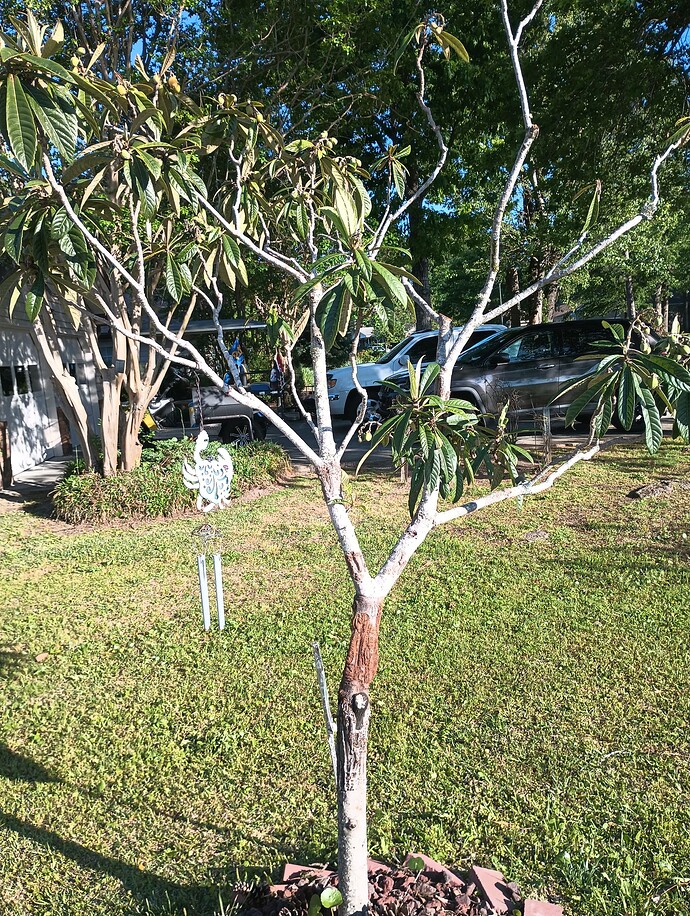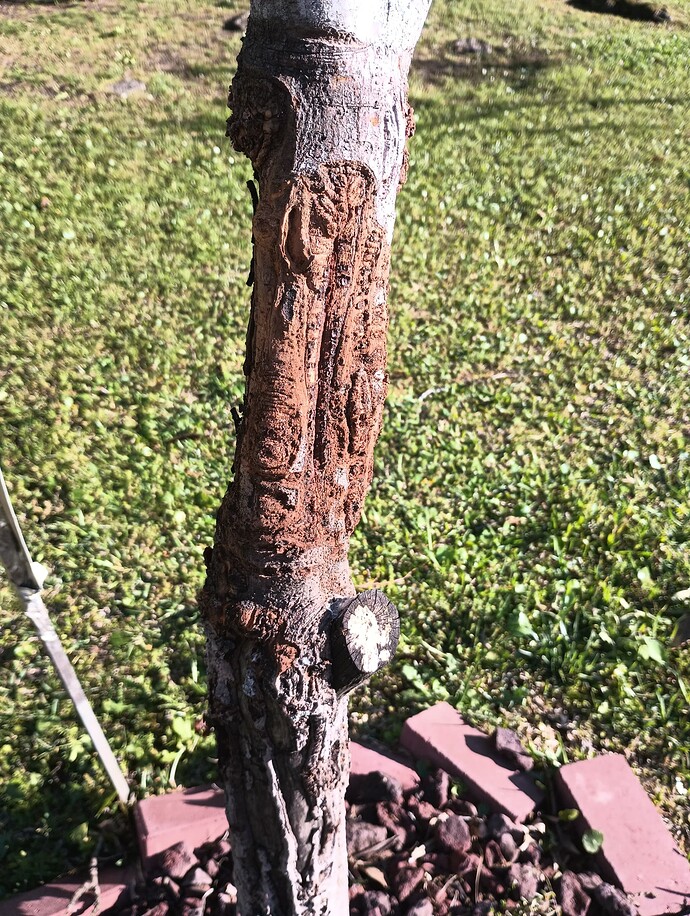I’m visiting my sister in Myrtle Beach,SC.There are two Loquat trees in the front yard.
After noticing some branches dying and talking with her, she said Woodpeckers come and peck them.
Here’s some pictures of one.A cloth had been attached for protection, but when removed,it was obviously too late.There is still life above the damage, even fruit,but this tree and possibly the other, which isn’t as bad are probably going to need replacement.
ive seen old apple trees with lots of woodpecker damage survive. if you can cover the worst spots with some screen maybe they will bounce back. fertilize and water them well for awhile. or if you want to start new, cut off the tree at about 3 ft. and cleft graft some young wood from the top of the tree before it declines too much. that would grow back alot faster than planting a new tree.
Woodpeckers and Sap suckers are there for another tasty problem.
The woodpeckers are there because some kind of insect is eating the tree from within. They are the symptom, not the cause, of the damage.
Had something like this on a service tree (cormus domestica) that was just flowering for the first time, which is about 10 years since planting. It was spring, the flowers dried and a 1/4 of the leaves were shrivelled. I treated the trunk with some insecticide, then next day soaked the Swiss cheese of a trunk with fungicide and after that dried, treated it with something like diluted grafting paint. Our resident woodpecker quintet has steered clear of it since.
Ditto what Danny and Jay said, the wood pecker may be causing the visible damage, but some insect or grub is inside causing the problem.
Nice observation.
Nice. Will keep this info in mind in case of some possible future need. Useful. Appreciated.
Maybe your sapsuckers are different, but the ones the rest of the world deal with fuck up healthy trees to eat their sap and or cambium, often killing them in the process. Sapsucker - Wikipedia
Yellow-bellied Sapsucker Overview, All About Birds, Cornell Lab of Ornithology
They’re pests that destroy trees regardless of tree health.
Insects arrive afterwards, because that’s what happens when you splash sugar water all over your front lawn.
Looks like we sometimes get Yellow belly Sapsuckers here. Pileated, Red Headed, Red Bellied, Downy , Red Cockaded and Northern Flickers are our main ones.
One misconception is that woodpeckers make holes only in search of insects. Many species will make holes in sound wood where no insects exist.
pasted from…https://extension.umd.edu/resource/woodpecker-and-sapsucker-damage-trees/
The term sapsucker is used for a reason- sap is food.
I’ve long assumed this to be the case based on many years of managing apple trees completely freckled with wounds and scars where searches by me for insects were futile. Birds don’t usually peck in search of insects- they peck where they sense them. I used to think damage was never lethal until a very large scaffold of a Fuji apple tree I was managing died for no other apparent reason. After that I came to the conclusion that older trees that lacked the vigor to hold up to these wounds are sometimes killed prematurely from such injuries.
They are a real problem in my region for maples and Norway spruces. I’ve seen burlap used, but it’s pretty ugly and holds too much moisture. Rigid black plastic netting or screen can be stapled onto trunks as well. I suspect it would be preferable.
Here’s something from chat ai about the most common way woodpeckers find insects.
The most common method woodpeckers use to find insects in trees is through a combination of visual scanning and drumming. Visual scanning allows them to detect any irregularities or movements on the bark, indicating the presence of insects beneath the surface. Once they identify a potential spot, woodpeckers use their strong beaks to drum on the bark. This drumming creates vibrations that disturb the insects hiding within the wood, making them easier to locate. By combining these two methods, woodpeckers can efficiently locate and capture their prey.
Sapsuckers are pretty amazing. They have a complex rotation of tree species they use at different times coinciding with when that species will produce the most sap. They both eat the sap and any insects that are attracted to it.
Woodpeckers all have distinctive drumming patterns, this loud pecking is specifically done to be loud and mark their territory. I’ve had a woodpecker drum on our metal mailbox for a couple years as a kid and one wore a spot in our grill cover drumming on it! Sapsuckers have a relatively slow and unsteady drum, they are the jazz drummers of the woodpecker world.
Drumming is very much unlike the pecking on wood they do to get their food which is usually punky/rotting because there are large amounts of insects (often but not always ants) living in the heartwood cavity.
We fortunately don’t have sapsuckers in Europe, but our woodpeckers sometimes make holes in trees to hold hazelnuts or acorns so they could crack them. I have an old pear tree that doubles as a nutcracker of sorts…
Back to the problem, Sepp Holzer mentioned making a thick version of whitewash to deter deer from eating the bark and killing younger trees. He made a paste from whitewash, clay and cow/horse dung. Could something like tgat work on sapsuckers?
they do lots of damage to cedar shingle homes and sheds. there’s rarely any bugs that will live in cedar. i always wondered why they do this. maybe a wall of wood is too good to pass up?
Maybe they’re just pretty shitty and very stupid like deer?
when i was a teenager, we lived in a old trailer for awhile. whenever i played music loud this wood pecker would go on our metal antenna and peck the heck out of it. it was like that most of that summer. who knew woodpeckers liked motely crue! ![]()
Sometimes birds go birdbrains. Not a year goes by when a male Bluebird does not get in a fight to the death with his reflection on my trailer mirror on the truck.
Annoying when they fall out and I have to save them from cats.

